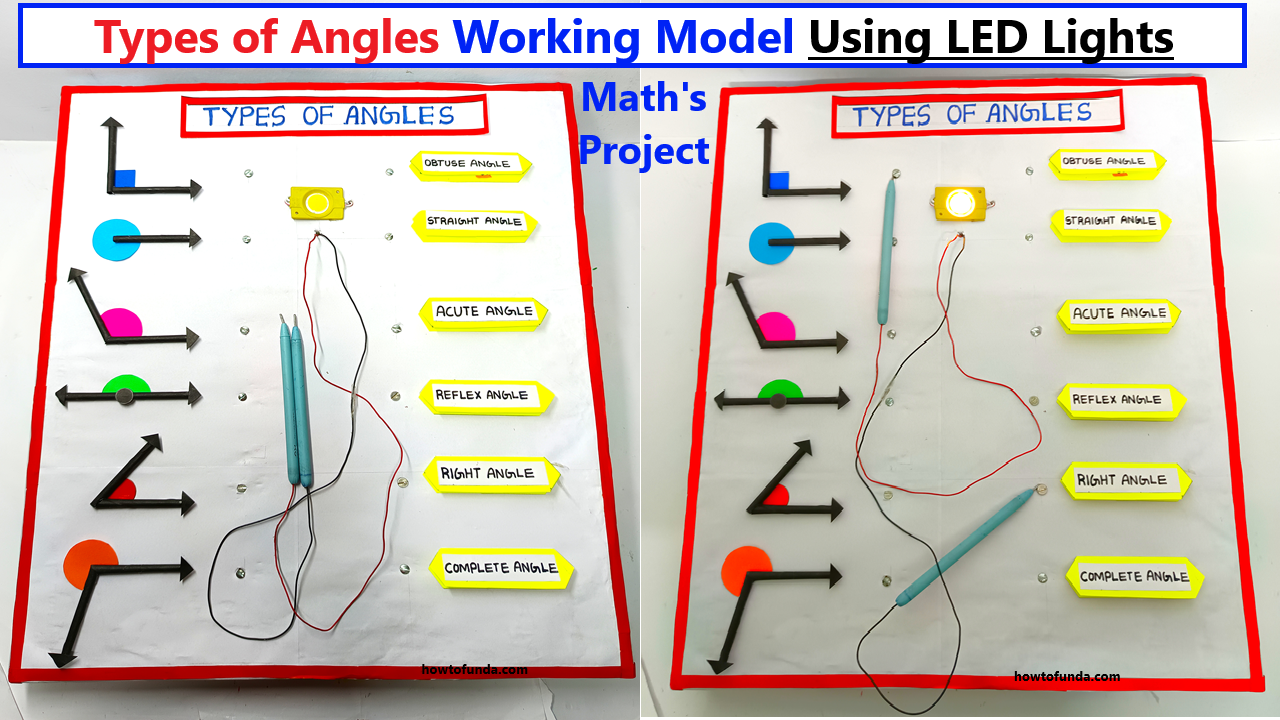Here are several mathematics projects using LED lights that are suitable for an exhibition. These projects make abstract mathematical concepts tangible and engaging

types of angles working model with led lights
Angles are an important part of geometry and are used in daily life—from the opening of a door to the turn of a steering wheel. To help understand angles clearly, this working model uses a match board base with LED lights to visually show how different types of angles are formed.
linear equations working model – maths project – led lights
This project helps students learn how to solve linear equations in an interactive way. You prepare a cardboard model with equations written on it. When the student presses the correct option button, the LED glows (connected with circuit). Wrong options won’t light up.
parallel lines and traversal working model with LED lights
Parallel lines and a transversal create many important angle relationships that are widely used in geometry. To explain these relationships in a simple and interactive way, this working model is designed on a match board using LED lights.
Algebraic expressions working model project with led lights
Algebraic expressions form the foundation of algebra and help us represent real-life situations using variables and numbers. To make this concept easy to understand, this working model uses LED lights on a match board/cardboard base to visually show the structure and components of an algebraic expression.
corresponding angles working model – maths project – using led lights
Corresponding angles are an important concept in geometry, formed when a transversal intersects two parallel lines. These angles lie in matching positions and are always equal when the lines are parallel. To make this concept easier to understand, this working model uses LED lights on a cardboard or match board setup.
real numbers working model with led lights (tree format)
In this model, the set of Real Numbers (ℝ) is placed at the top as the root of the tree. From it, branches divide into Rational Numbers and Irrational Numbers. The rational numbers branch further into Integers, Whole Numbers, and Natural Numbers. Each branch is fitted with LED lights that glow when activated, helping viewers clearly see how different types of numbers are connected and organized within the real number system.
pythogorous theorem working model with led lights
In the model, a right-angled triangle is shown along with three squares built on its sides. LED lights are placed inside each square. When the switch is pressed, the LEDs inside the two smaller squares (representing a² and b²) glow first, and then the LEDs inside the largest square (representing c²) glow, demonstrating that a² + b² = c². This light-based visualization helps students clearly see the relationship between the sides of a right-angled triangle.
3d shapes working model with led lights
In this model, common 3D shapes such as the cube, cuboid, cylinder, cone, sphere, and pyramid are displayed using mini models. Each shape is connected to an LED light system. When a switch is pressed, the LED for that particular shape glows, highlighting its structure along with key information such as faces, edges, vertices, curved surfaces, and real-life examples. This makes it easier for students to visually compare shapes and understand their unique characteristics.
parts of circle working model using led lights
In this model, the circle is divided into important components such as the radius, diameter, chord, arc, sector, segment, centre, and circumference. LED lights are placed along each part. When a switch is pressed, the LED for that specific part glows, helping students instantly identify and understand how each component looks and where it lies on the circle. This interactive lighting makes the abstract parts of a circle easy to visualize and remember.
pie chart graph maths working model with LEd Lights
In this model, the circle is divided into different sectors, each representing a category of data. LED lights are placed inside every sector. When a switch is pressed, the LEDs for a selected sector glow, highlighting its size and percentage visually. This helps students clearly understand how each part contributes to the total data set. The glowing sectors make the concept of data interpretation simple, fun, and memorable
triangle formulas working model using led lights
In this model, different types of triangles and their key formulas—such as area, perimeter, Pythagoras theorem, Heron’s formula, height formulas, and angle relationships—are displayed. LED lights are connected to each formula or triangle type. When a switch is pressed, the LED for that specific formula lights up, helping students clearly see and understand how it applies to the triangle shown. This makes the learning process interactive, visual, and memorable.

